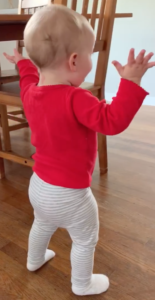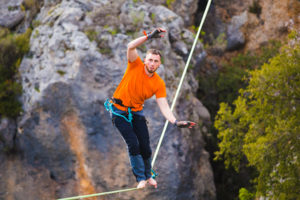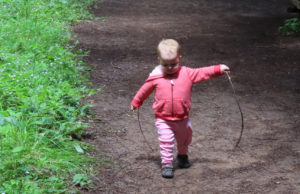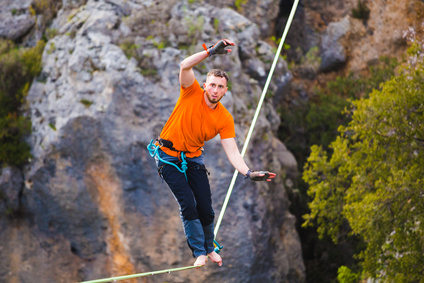The Conscious Art of Balance

Watching videos of my great-niece learning to walk, I am struck by her dedicated focus on the task of upright balance – and the pure joy in the accomplishment of that task. It reminds me of her delight when, as a wee babe, her father would fly her around the room in his arms. Now she flies through space on her own small feet.
Balance is a wonder, an amazing feat (no pun intended) that we learn to accomplish at the beginning of life. Gradually, as we gain mastery over gravity’s sway, balance becomes an automatic skill – one that no longer requires focused attention. My great-niece already begins to take conquering gravity for granted; she focuses instead on the wonders her new found skill sets her free to explore.

The unattended ability to stand upright serves across a lifetime – unless or until a challenge threatens to knock us off our feet. Sometimes we seek out such challenges – a narrow log, a tightrope wire, an ice skating rink – conditions that engage the same intensity of focus and level of delight my great-niece exhibited in first learning to walk.
Other challenges, however, come uninvited: joint stiffness and pain; neuropathy; vertigo; a sudden wobble for no apparent reason. Now the threat of toppling-over grabs attention, sometimes triggering a lasting fear of falling. Unfortunately, the intense awareness elicited by fear only ups the likelihood of a fall.
So what’s the difference between how we pay attention when we’re afraid of falling and the kind of focus that helped us learn to stand and walk and even enjoy equilibrium challenges in sports and at play?
Reactive Avoidance versus Proactive Engagement
Unexpected instability “trips” an attentional alarm in the same way as, say, hearing a sudden loud noise. It’s a kind of fight, flight or freeze reaction: the potential danger arrests awareness and response. A moment ago the soundscape around me went on without notice; now it holds my full attention.
The same is true with balance: it goes on without notice until something goes wrong. There’s an interesting difference, though, between balance perception and hearing and seeing: our sense of balance is immediate to the decision-making that guides the movement that keeps us upright. That is, unlike listening intently before deciding what to do about a loud noise, a movement response to perceived instability happens at once. The link between perceiving where we are in space in relationship to gravity and the physical act of maintaining balance is so immediate that we tend to overlook the essential role of perception in our ability to stand.

With sudden instability, reflex takes over that immediate link. With intentional participation in a balance challenge, whether an infant attempting to stand and walk or an adult stepping onto a slack line, balance awareness precedes and enhances adaptive movement control. In other words, one is about avoiding a fall, the other is about accomplishing a skill.
The challenges presented in aging tend to trigger the fearful reflexive act of fall avoidance. It doesn’t have to be that way. While the sources of challenge may differ dramatically from those of the past, the resource of proactive awareness remains at our disposal – as does its positive effect on stability. The lessons from earlier life experience can help us rediscover the conscious art of being in balance.
Minding Balance
The conscious art of balance doesn’t take anything extraordinary; paying attention to postural alignment relative to gravity is something we’ve done since before we learned to talk. It simply means intentionally bringing awareness to a perception we’ve taken for granted most of our adult lives.
Just notice the feel of posture and body weight – are your shoulders and torso supported over your hips, legs and feet? Muscles relax when they’re supported – feel the drop of relaxed weight through your bones into the ground.

Recognize what happens to postural alignment when you look and reach and turn. As adults, we unconsciously tend to curl forward when looking down, e.g., checking the cellphone. Add joint stiffness and an uneven sidewalk to this already unstable posture – we fall without warning and wonder why. My great-niece who, like all toddlers, has the challenge of relatively small feet and a large head, learned early on to tilt her chin down while keeping vertical alignment of the rest of her body. With awareness, we can do the same.
Toddlers also discover the utility of organizing movement around the pelvis, a realization shared by gymnasts and martial artists. In the martial art Ki-Aikido, we refer to this as moving from center. Bringing awareness to the center of balance in the lower abdomen turns up the light on balance perception, and in so doing helps organize more coordinated and stable movement.
Consciously tuning in to the perceptual side of balance helps us move beyond fear and fall avoidance to rediscover the art and freedom of conquering gravity.

One comment